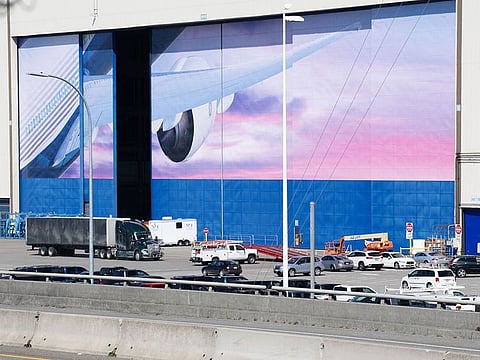Boeing to take a painful decision on the 787 and jobs with it
Any more cuts in mega-jet production will mean job losses in the thousands

Seattle: Boeing Co. is poised to cut 787 Dreamliner output by about half and announce workforce reductions when it reports first-quarter earnings next week.
Details of the production changes for Boeing’s commercial lineup are still being finalized and will determine the number of jobs to be eliminated through layoffs and buyouts. The planemaker plans to lower the Dreamliner’s monthly output, which began the year at 14 jets, to a single-digit rate.
Dave Calhoun, Boeing’s CEO, hinted that painful measures would be needed when he warned employees last month of a “new reality” with a far smaller jetliner market when the world emerges from the coronavirus pandemic. Global airline sales are projected to plunge by $314 billion this year, according to an industry trade group, and travel may not recover fully until mid-decade.
Double trouble
The forbidding landscape leaves Boeing with no easy decisions. Airbus SE, its European rival, has already announced plans to pare output by about a third. Both companies probably burned through record amounts of cash in the first quarter: 6.5 billion euros for Airbus and $8 billion for Boeing, according to calculations by Melius Research analyst Carter Copeland.
The US manufacturer faces added strain from maintaining 400 or so newly built 737 Max jets that are stuck in storage until regulators lift a grounding imposed more than a year ago after two fatal accidents.
“Boeing is facing essentially a self-made problem on the Max and an act of God on the virus,” said Robert Spingarn, an analyst with Credit Suisse Group AG. “These two things together create just an unbelievably difficult situation to have to manage through.”
Swing in fortunes
Even US President Donald Trump acknowledged the difficult restructuring ahead when he riffed on Boeing’s dilemma during an April 10 briefing.
“We know they’re going to need help,” he said of the prospect of the aviation colossus tapping federal aid. “But should they keep the people they actually don’t need? That business is a very cyclical business like many businesses, frankly. So that determination has not been made.”
A decision about slowing the production tempo for the 787 reaches far beyond steps such as the temporary, virus-induced pause of Boeing’s commercial-jet operations. Any increase or decrease in that pace is hugely significant, affecting the size of the workforce and the flow of thousands of parts through a delicately balanced supply chain stretching around the world.
While Boeing doesn’t break out the number of employees working on individual models, the 787 programme involves thousands of people, spread between the planemaker’s wide-body factory in Everett, Washington, and a Dreamliner-only plant in South Carolina.
Finding cash
Suppliers have also been in limbo as they make their own decisions on whether to maintain staff and order raw materials.
“We don’t know where Boeing is going to go, but they’re going to be lower, and that’s what we’re anticipating,” said Nick Stanage, CEO of Hexcel Corp., which supplies material for the 787’s carbon-fiber frame. “That’s what we’re positioning our operations to manage to.”
The savings from the production changes and downsized organization will determine how much money Boeing needs to survive a prolonged downturn - another likely discussion point for the company’s April 29 earnings call with analysts. Boeing has been analyzing whether to raise about $10 billion to $20 billion through newly available financing from the Federal Reserve and CARES Act rescue legislation, as well as the debt markets.
Investments from the likes of Warren Buffett’s Berkshire Hathaway Inc. and sovereign funds are other options, but Boeing is focused on federal aid as it awaits Treasury Department guidelines, said one of the people familiar with the discussions.
Lengthy disruption
While the planemaker isn’t in imminent financial danger, travel patterns and demand may be disrupted for years, crimping jet sales.
Businesses will probably lean more on teleconferences, while executives and leisure travelers alike may have qualms about sitting in confined quarters with hundreds of other airline passengers before there’s a vaccine for the deadly new coronavirus. About 16,700 commercial jets are currently parked, equivalent to 64 per cent of the global fleet, according to aviation consultant Cirium.
“There’s probably no airline in the world that needs or wants an airplane right now,” Ron Epstein, an analyst with Bank of America Corp., said.
Demand was fading for aircraft designed for long-haul routes even before the pandemic caused the travel industry to unravel, Spingarn said. After pushing 787 Dreamliner output to a record 14-jet monthly pace last year, Boeing had already announced two production-rate cuts that would lower output to 10 Dreamliners a month next year. And that was before the outbreak turned into a global nightmare.
Spingarn, the Credit Suisse analyst, estimated that Boeing would need to reduce the Dreamliner production rate to eight jets a month for the final three quarters of 2020 before taking output a step lower next year to a six-jet pace.
“I don’t think it’s ever going back to 10,” he said of the monthly production rate.
Sign up for the Daily Briefing
Get the latest news and updates straight to your inbox







